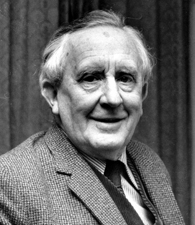Philologist and English professor J.R.R. Tolkien popularized an entire genre of literature when he wrote his fantasy epic “The Lord of the Rings,” a story built upon an elaborate mythology, set of languages, and detailed landscape that took years of work.
J.R.R. Tolkien’s Early Days
John Ronald Reuel Tolkien was born in Bloemfontein, South Africa, on January 3, 1892, to English parents. When his father, Arthur Reuel Tolkien, died in 1896, the family returned to England. Tolkien’s mother Mabel died from diabetes when he was 12. He and his brother Hilary were brought up in a boarding house; a local priest was a father figure to them both.
Tolkien graduated from Exeter College with a degree in English Language and Literature in 1915, after which he fought in World War I. He then worked for the Oxford English Dictionary for several years before joining the English faculty at Leeds University. In 1925 he assumed the Rawlinson and Bosworth Professorship of Anglo-Saxon at Oxford University, where he spent the rest of his academic life.
Sources in This Story
- The Tolkien Society: J. R. R. Tolkien: A Biographical Sketch
- Tolkien-Online.com
- findingDulcinea: “New” Tolkien Novel Published
Notable Accomplishments
After the war, Tolkien began building the mythology, landscape and languages of the Middle-Earth world. He wrote a few Middle-Earth stories in the next several years, but no novel was started until the summer of 1928. He was grading test papers when he scribbled the words, “In a hole in the ground there lived a hobbit” on a student’s blank answer sheet.
The chairman of the publishing house Allen & Unwin gave the manuscript to his 10-year-old son, and the boy’s favorable review convinced him to publish Tolkien’s fantastic tale. On September 21, 1937, the first copies of “The Hobbit,” subtitled “There and Back Again,” appeared in English bookstores. With its illustrations and maps drawn by Tolkien, the book gained immediate popularity. By Christmas the publisher had sold out of its first printing. The American version sold 3,000 copies in the first two months. Tolkien’s three-volume “The Lord of the Rings,” wasn’t published until 1954 and 1955. Its popularity, though, far outpaced that of “The Hobbit.” “The Lord of the Rings” trilogy is ranked among the most-read literary works of the 20th century. Many fantasy novels written after the trilogy’s publication clearly owe a great debt to Tolkien.
The Rest of the Story
Although his life may seem to have been consumed by Middle-Earth, Tolkien wrote stories that were not set there, including “Farmer Giles of Ham” and “Smith of Wootton Major.” He also wrote scholarly articles about language and the nature of storytelling, and made important translations of Middle English poems such as “Sir Gawain and the Green Knight” and “Orfeo.”
Tolkien died September 2, 1973, at the age of 81. He is buried in the same grave as his wife, Edith, with the inscription “Beren” below his name, and “Lúthien” below her name, in honor of a pair of tragic lovers from his Middle-Earth mythology.
Tolkien’s son Christopher began collecting, editing and publishing various unpublished stories and incomplete story drafts that contributed to the early mythology of Middle-Earth. These collections include “The Silmarillion,” several volumes of “Lost Tales,” and most recently, “The Children of Húrin.”
From 2001–2003, producer/director Peter Jackson released three blockbuster films based on the “Lord of the Rings,” followed by three more films based on “The Hobbit” that were released between 2012 and 2014.
This article was originally written by Amy Goldschlager; it was updated January 4, 2018.











